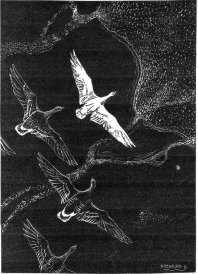

BB was probably never happier than when out with his gun and dog either ‘working’ the fields and hedgerows of his beloved Northamptonshire countryside for pheasant or partridge; in woodland ambush awaiting the pigeons returning to their evening roost; or whilst hanging fire for the dawn flight of the geese in his favourite Scottish and North Country salt-marsh hunting grounds.
For him shooting provided an eternal link with his boyhood and youth and with a countryside so rich in wildlife that man the hunter could be an acceptable part of the rural environment. He was no mindless killer and he never enjoyed the kind of formal shooting that gave people the chance to kill hundreds of pheasants in a day. For BB shooting was a means to get closer to nature and the countryside and to replenish his stockpot!
The tenseness and expectancy that he experienced while waiting for a shot at a rabbit, a pigeon or a pheasant kept him shooting for more than seventy years. He also enjoyed the simple practical pleasure of a man pitting his wits against a wild creature. It was an article of faith with BB that a man should never shoot something unless he intended to eat it. Killing would otherwise represent a betrayal of one’s quarry.
Although he was particularly fond of rough-shooting, wildfowling was perhaps his greatest love. The attractions of this most demanding of country sports were of course much like those of fishing: solitude, a sense of wonder at the beauty and wildness of the places haunted by the wildfowl, and the idea of one man trying to outwit a wild creature in the creature’s own environment where man was often at a disadvantage or even at times in some danger.
BB’s matchless descriptions of wildfowling are unforgettable. The splendour of dawn and sunset over the silver firths; mornings of blizzard and mist upon the high frosted uplands where the geese come to feed; the abiding peace of evening on the tide or the wild waves breaking on the shore and always in the background, the cries of the wildfowl in the starry night, the calls of goose or curlew; all these he describes with his wonderful attention to detail and impelling charm.
BB went regularly to the Wash in January, and to Scotland. He rarely shot more than one or two geese on each expedition and was deeply saddened towards the end of his life at annual reports of the slaughter of large numbers of geese by unscrupulous longshore gunners, many from abroad.
To give BB the last word:
“One thing I unblushingly own. I have devoted more that my allotted span of pages to wildfowling. This is a luxury I have allowed myself, because of all the forms of shooting this is, to my own tastes, the finest. It is the last real ‘wild’ hunting that is left to us with the exception perhaps of deer stalking. It is also the most unpopular form of shooting, and I never cease to give thanks for this fact. Wildfowling is no game for old men; it calls for the best physical condition, a sense of woodcraft, or should I say ‘marshcraft’, a clear eye, sound wind, and a total disregard of cold and wet. Above all it requires patience, the inexhaustible patience of the coarse fisherman, who, like the wildfowler, more often than not returns empty-handed.”
(The Shooting Man’s Bedside Book - 1946)
